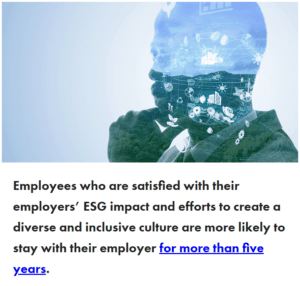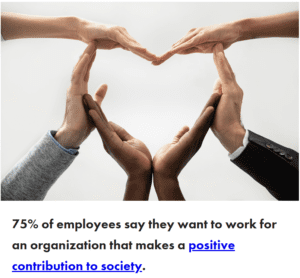In the midst of The Great Resignation, organizations can benefit from showcasing their commitment to social and environmental matters.
By Kevin Crow
More than four million Americans have quit their jobs every month during The Great Resignation so far. And with inflation hitting a 40-year high, workers now have an even greater motivation to change jobs in pursuit of a pay bump. A recent global PwC survey found that more than one third of respondents plan to ask for a raise in the coming year and one in five are likely to switch employers.
Companies are pulling out all the stops to hold onto their best workers by providing better compensation packages, remote work options, four-day work weeks, unlimited vacation, and more. While these perks are valuable, there’s a growing retention and recruitment driver that deserves greater attention: environmental, social, and governance (ESG).
The Link Between ESG and HR
The “social” element of ESG focuses on the way a company treats people within the organization and the communities in which it operates. Data shows that employees increasingly want to work for companies that take social matters seriously.
Three out of four job seekers report diversity is an important factor when choosing where to work and another 75% say they want to work for an organization that makes a positive contribution to society. Employees who are satisfied with their employers’ ESG impact and efforts to create a diverse and inclusive culture are more likely to stay with their employer for more than five years. Other in-demand workplace characteristics include fulfilling work opportunities, the ability to be one’s authentic self at work, and support in translating ESG considerations to employees’ daily work.
Organizations also need to address environmental matters. Workers are increasingly conscious of an organization’s environmental impacts and what they’re doing to reduce their footprint. According to an IBM survey, 67% of employees say they are more willing to apply for positions with environmentally sustainable companies and 68% are more willing to accept these positions.
In other words, the employers that prioritize ESG performance, govern in a way that takes care of their employees and the environment, and show they are genuine in their commitments, will have a leg up on competitors in the war for talent.

Employees who are satisfied with their employers’ ESG impact and efforts to create a diverse and inclusive culture are more likely to stay with their employer for more than five years.
Three Steps to Take Now
There are key steps companies can take to show workers that they foster a culture dedicated to ESG.
1. Build trust with workers by committing to transparency through reporting. Employees want to know where the companies they work for stand on ESG issues. Fifty-four percent of workers say transparency around how an organization addresses diversity and inclusion (D&I) in the workplace is extremely important. Additionally, 53% say the same about a company’s impact on the natural environment and climate change.
Top talent now expects for organizations to regularly disclose ESG metrics, goals, and progress, and leaders should work together and with their risk and compliance teams to get a solid, clear, and consistent reporting process in place. These reports are an opportunity to prove to workers that the company is committed to creating an inclusive and rewarding work environment and are dedicated to positively impacting society and the planet. Beyond annual reports and other formal documentation, encourage the sharing of key milestones and initiatives during company-wide meetings, on corporate social media accounts, and across other channels where workers and prospective candidates engage.
2. Choose metrics to measure ESG progress. A variety of metrics fall under the category of ESG – workforce demographics, executive compensation, adherence to labor standards, greenhouse-gas emissions, air and water pollution, and energy efficiency, among others. Given there isn’t yet a universally accepted ESG reporting standard, meeting employee demands for information requires companies to decide on the ESG metrics that work best for them.
Metrics should be chosen based on an organization’s values, purpose, and mission. Leaders should ask employees what’s most important to them and consider what prospective talent will want to see. Communicate the reasoning behind choosing these metrics within reports and when sharing progress updates.
Keep in mind, many ESG metrics of interest to workers will fall outside of HR’s purview. Product safety, data protection and privacy, emissions data, and responsible sourcing practices are key indicators of an organization’s impact. Collaborate with other departments to get these insights to give talent a well-rounded view of company performance.
3. Leverage technology to get data in order. Data collection is the biggest obstacle when effectively communicating about ESG. Key information tends to live in many locations across the organization and in various formats and spreadsheets. Companies often don’t know what information is available, where to find it, and what else might be needed to create a true and compelling picture of their performance.
This is where technology comes into play. Lean on integrated software to automate data collection and reporting. These tools can bring all critical ESG data into one place in real time and make it easy to build reports. Businesses will be in a much better position to communicate their ESG efforts to workers in a credible, cohesive, and powerful way.

75% of employees say they want to work for an organization that makes a positive contribution to society.
Progress Outweighs Perfection
A company’s ESG performance is becoming an increasingly important factor in attracting and retaining talent. But workers don’t expect perfection. They want to see that their employers understand the organization’s impact, are accountable for ESG issues, and are dedicating the resources and effort to improve.
Regularly disclosing progress sends the signal that meeting today’s standards for an inclusive, socially responsible, and environmentally sound workplace is a priority. Collaborate with other company leaders to refine a reporting process. Doing so will create an invaluable edge in today’s tight labor market.
Kevin Crow is CHRO for Riskonnect














